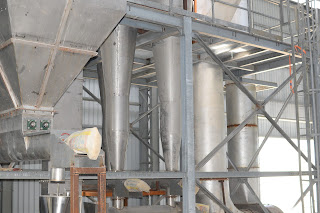Dave Ikiedei Asei
19/05/2019
Yesterday we took a look at some of the uses of the Ebedebiri multi-billion
Naira Cassava and Starch Processing factory nearing completion courtesy of the country man Governor, Henry Seriake Dickson at Ebedebiri, Sagbama Local Government Area, Bayelsa
State. As an expert in the Agricultural field, the honourable Commissioner for
Agriculture and Natural Resources, Honourable Doodei Agbabou and the Group Managing Director of the Bayelsa State Agricultural Development Board, Mrs Helen Akinaboh Ajuwa are ably
piloting the affairs of the project. They are capable hands supervising this gigantic project. The Governor made the
best choice of appointing the Honourable Commissioner and the Managing
Director, both are tested and capable hands which have made it possible to bring
this investment to 80% completion.
Today, we will still consider additional uses and benefit of
building this great project that will lay the foundation of industrializing
Bayelsa State which will create a shift from dependence on the federal
allocation accruing from the sale of crude oil and Gas.
The following are some products from the Cassava and Starch
Processing factory at Ebedebiri -
1.
PARTICLE BOARD FROM CASSAVA STALKS
As cassava cultivation increases, more stalks will become
available for disposal. The Tropical Products Institute, London, has been
working on the utilization of the cassava plant. Particle boards could be made from
cassava stalks by cutting them into small sections and mixing them with certain
resins. The strength of the board can be varied by altering the resin content
or the density.
FERMENTED PRODUCTS
2.
CASSAVA ALCOHOL
Cassava is one of the richest fermentable substances for the
production of alcohol. The fresh roots contain about 30 percent starch and 5
percent sugar, and the dried roots contain about 80 percent fermentable
substances which are equivalent to rice as a source of alcohol.
Ethyl alcohol is produced from many carbohydrate materials. In
Malaysia and some other countries, many factories are equipped to use cassava
roots, starch or molasses (by-product of the sugar industry), the type of
product depending on the costs of the raw materials. When cassava is used, the
roots are washed, crushed into a thin pulp and then screened.
Saccharification is carried out by adding sulfuric acid to the
pulp in pressure cookers until total sugars reach 15-17 percent of the
contents. The pH value is adjusted by using sodium carbonate, and then yeast
fermentation is allowed for three to four days at a suitable temperature for
the production of alcohol, carbon dioxide and small amounts of other substances
from sugar. Alcohol is then separated by heat distillation. The yield of
conversion is about 70-110 litres of absolute alcohol per ton of cassava roots
depending on the variety and method of manufacture. The crude alcohol of
cassava is described as average in quality. It has a disagreeable odour, but
can be improved if the first and last fractions in the distillation process are
discarded. It is usually utilized for industrial purposes, as in cosmetics,
solvents and pharmaceutical products. If the production is required for human
consumption, special care should be taken in handling the roots to rid them of
hydrocyanic acid.
2. DRIED YEAST
Microbial protein is attracting growing interest owing to the
enormous protein requirements of the world. Among the microorganisms which are
considered possible food sources, yeast has perhaps stirred the greatest
interest. Candida and saccharomyces yeasts have had a well-established place
for many years as feed, and the technology of production, the composition and
the nutritive value of yeast are well known.
Most of the production of yeast is based on such low-cost raw materials as waste liquids, wood hydrolyzates and molasses. Starch-rich plant materials from wastes or surplus production are also utilized as substrata for yeast production. Cassava starch and cassava roots are being used in Malaysia and some other countries for the production of yeasts for animal feed' the human diet and for bakery yeast. The starch is hydrolyzed into simple sugars (predominantly glucose) by means of mineral acid or by enzymes. Certain yeasts are then propagated which assimilate the simple sugars and produce microbial cellular substances. The dry, inactive yeast contains about 7 percent moisture and the raw protein content can vary between 40 and 50 percent depending on the raw material.
The yield of yeast production also depends on the raw material. In some applications of cassava starch conversion into substances obtained from yeasts, a 38-42 percent yield of yeast product containing.
Governor Dickson is setting the pace in
the industrialization process of Bayelsa State by bringing to fruition his
dream of an industrialized and production hub in the Niger Delta.
The Dickson has managed the income
accruing to the State prudently and has set up several productive venture of which this factory is one of them.
I congratulate the Governor, the Honorable Commissioner
for Agriculture and Natural Resources, Doodei A. Week and the Managing
Director of the Bayelsa State Agricultural Development Board, Mrs Helen Akinaboh Azuwa
for their competence and diligence in supervising and management of the
construction of this specialized plant.






























No comments:
Post a Comment